Long, before the advent of Islam, even as early as the third millennium BCE, India had cultural bonds with the Mesopotamian civilization, now the region of Iraq and Iran. As explained by N. N. Bhattacharya, there are plenty of references to establish a very close contact between India and the Islamic world. Actually, Iraq was an area that had been a part of the Vedic civilization at one time. The extreme antiquity of India’s trade with the West-Asia (now known as middle-east) is an established fact.
In the Rig Vedic age, Afghanistan and its neighboring countries were culturally a part of ancient India, Bharatvarsha, and ancient Iran was also hardly distinguishable from India. It is recognized that some forms of Vedic culture prevailed in Western Asia. According to the Syrian writer Zenob, there was an Indian colony in the canton of Taron (in the region of modern day Turkey) on the upper Euphrates, to the west of Lake Van, as early as the second century BCE. Two temples were built there containing images of the Vedic divinities as large as 18 and 22 feet high.
According to Dr. Sayce, a pioneer British Assyriologist and linguist the commerce by sea between India and Babylon must have been carried on as early as about 3000 BCE, when Ur Bagas, the first king of United Babylonia, ruled Ur of the Chaldees. Indian teak wood is believed to have been found in the Babylonian remains of the third millennium BCE, and Hewitt is of the opinion that this wood must have come by sea from some port of the Malabar coast. (Mookerji, Indian Shipping, p. 86) Herodotus even explains that Babylonia imported precious stones from India. (Cowell, Jataka, III, p. 83) The Baveru Jataka (no. 339) speaks of the visit of Indian maritime traders to the kingdom of Baveru (Babylon), which may refer to the Seleucid empire, established in 312 BCE., with its capital at the city of Babylon.
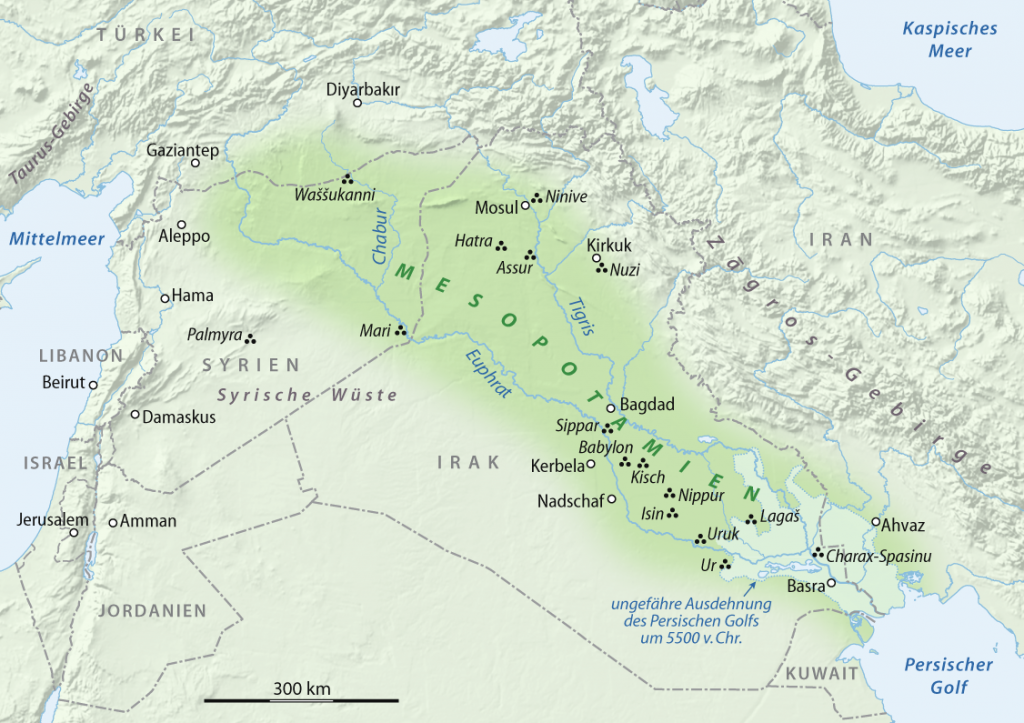
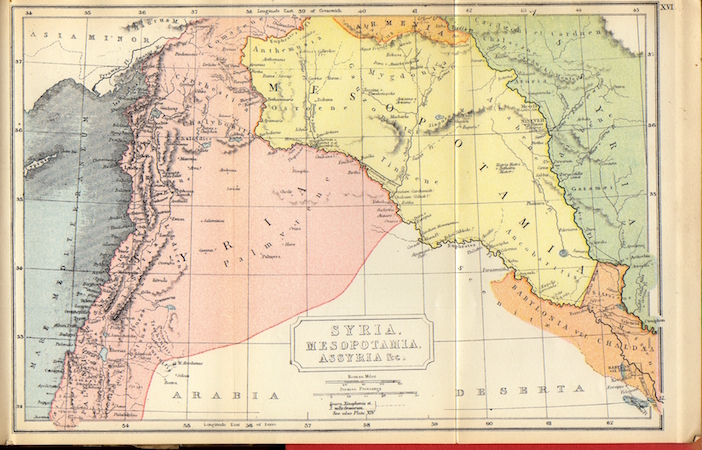
Sandalwood, rice and peacocks were exported from India to Babylonia. It may also be pointed out that Phoenician trade with South India has been traced from the fact that peacocks brought by Hiram’s ships to Solomon were called tuki derived from Tamil Tagai. In pre-Islamic days Indian spices were imported in large quantities into Arabia, and Indian wares were sent to the mart of Batene. Arabic words like Quaranful are derived from Indian names like Karan-phul. The word, made of Indian steel, is proverbial in Arabic literature. Thus we can safely conclude that there were trade relations between India and Western Asia from times immemorial. Some scholars say that this trade may have been interrupted with the rise of Islam, when Arabia became the seat of Islam.
IRAN
Parthia or Persia, now Iran, was the land where several tribes connected with the Vedic tradition had settled, such as the Druhyus, Panis, Parsas, and Bisnois. They all followed various Vedic practices, such as fire rituals and Sun worship, many of which were later incorporated in ways into Zoroastrianism. Support by the rulers for such practices went on for sometime until the area was taken over by Muslims, after which many of the architectural monuments were also lost.
In the Vedic period during the time when Parashurama defeated the Kshatriyas 21 times, many of the defeated Kings, those who refused to follow or be a part of the Vedic civilization, left the region of India to find their own place to live. These people were known as Parshvas, and resided in Persia. These people later became followers of Zoroastrianism wherein they worshiped Asur Medha, or Asur Mahta, later called Ahurmazda. Today they are known as Parsis.
Dr. Poonai has also written that Persia was named after the Vedic axe warrior Parashurama. “The doctrines of the Vedas were therefore widely taught to the noble people of Iran, also called Purusham Aryanam, a phrase which can be abbreviated to Parsianam or Parthians or Persians.”1
More recently, Dr. Peter B. Clarke, editor of The World’s Religions (1993, p. 130), writes that the name Iran is derived from Aryan, and Aryans inhabited that ancient Iran.
T. Burrow in The Sanskrit Language (2011, p.4) explains:
The relations between this ancient Iranian and the language of the Veda are so close that it is not possible satisfactorily to study one without the other… It is quite possible to find verses in the oldest portion of the Avesta, which simply by phonetic substitutions according to established laws can be turned into intelligible Sanskrit.
Dr. Jagat K. Motwani, nicely summarizes:
It clearly suggests that the Iranian Aryans and the Indo-Aryans were one and the same people in ancient times when they ‘lauded the same gods with the same hymns, and worshipped them with identical rites.’ The people may not have been known as Hindus or Persians at the time. All the people of the subcontinent, including Indians, Iranians, Nepalese, Bhutanese, Sri Lankans, Burmese, etc., must have been called Aryans, as the country was known as Aryavarta, Aryadesh, or Aryabhoomi. The unfounded theory of the Aryan Invasion–engineered in London and guided by the world-known British policy ‘Divide and Rule’–seems to have divided Indians and Iranians who, in ancient times, were one and the same people.2

Max Muller had written:
The Zoroastrians were a colony from Northern India. They had been together for a time with the people whose sacred songs have been preserved to us in the Vedas. A schism took place and the Zoroastrians migrated westward to Archosia and Persia.3
He goes on to explain,
Still more striking is the similarity between Persia and India in religion and mythology. Gods unknown to any Indo-European nation are worshiped under the same name in Sanskrit and Zend.4
In the Iranian religion the ritual was called the yazna, in which a festive meal would take place and a god would be invited to attend, in which fire and a sacred drink, called houma, would be offered. This would be done in the open air, outside, often performed by the priestly clan, called the Magi. Through the performance of such rituals, blessing from the gods would be attained.5
This is very similar to the Vedic tradition, in which the ritual was called the yajna (pronounced as yagya), or the homa ritual, with a central fire that would become the vortex to the deity or the mouth of the deity, and the sacred drink called soma would be offered, and then consumed as prasada. This would often be performed by the priestly class called the Brahmins (Brahmanas). So the Iranian ritual is likely a direct carry-over from that Vedic tradition.
In Introduction to the Aitareya Brahmana (Vol. I, page 23), Dr. Huang, another noted Indologist, writes:
The ancestors of the Brahmans and those of Parsis (the ancient Iranians) lived as brother tribes peacefully together.
This indicates that when the Parsis came to India in 910 CE, to escape the religious persecution they were suffering at the time at the hands of the Muslims, they were merely returning to their original home.
However, Persia had the Vedic culture and its spiritual philosophy before Zarathustra founded the Zoroastrian religion. Their religious gatha “Zend Avesta” is “Chhanda Avastha” as part of or derived from the RigVeda. In fact, Lord Vishnu was worshiped in the region even after the arrival of Islam. For example, Arminius Vambery, a Hungarian writer who has traveled extensively through several Muslim countries, relates that near the city of Shiraz in Iran is a village named Saadi. The village gets its name from the poet Saadi, who is buried there. This Saadi, a Muslim by birth, was a devotee of the Vedic deity Vishnu. Vambery writes,
He even assumed the religion of the worshipers of Vishnu in order to extend and increase his knowledge of all things.6
Sir W. Drummond also corroborates this in Origins of Several Empires:
In the early ages of the world, the inhabitants of Iran and India were governed by the same laws and were united as one people under the same monarchy.
Sir William Jones, as quoted by Lt. General Charles Vallancy, says,
It has been proved by clear evidence and plain reasoning, that a powerful monarchy was established in Iran, long before the Assyrian government, that it was in truth a Hindoo monarchy that subsisted for many centuries and that its history has been engrafted on that of Hindoos, who founded monarchies of Ayodhya and Indraprastha.
From his book, The Aryans: A Study of Indo-European Origins, V. Gordon Childe writes that the Mitannis were warriors (Kshatriyas) from India:
Finally we know that there existed among the Mitanni at this time a class of warriors styled marianna which has suggested comparison with the Sanskrit marya, young men, heroes.7
Childe goes on to describe the dynasts installed in the Mesopotamia region, who were perhaps Mitanni and Hittites:
So it is clear enough that the dynasts installed on the Upper Euphrates by 1400 B.C. were Aryans, closely akin to those we meet in the Indus Valley and later in Media and Persia. But their subjects were non-Aryan Asianics, and the rulers had adopted the native language and the Babylonian script for their official correspondence, and apparently acknowledged local gods besides their own.
Dr. Peter B. Clarke (ed), in The World’s Religions (1993: p.130), writes that the name Iran is derived from Aryan. He seems to suggest that Iran, in ancient times, was inhabited by Aryans. The old Iranian language Avestan was very close to Sanskrit.
This is in line with the more recent research of C. V. Vaidya as he explains in History of Sanskrit Literature (1986, vol. 1, pp. 39-40) wherein he gives lingual evidence in Sanskrit and Avestan to establish that in ancient time, the Indian Aryans and Iranians lived together, but were also one people. The evidence he uses is that the Avestic gathas and the Rig Veda mantras were extremely similar and sometimes identical.
Argument again in favor of a late date for the Rigvedic hymns is sought to be derived from the extreme similarity of Avestic gathas and Rigvedic mantras which are sometimes identical. There is no doubt that the Indo-Aryans and the Iranians once formed one people and lived together.
They naturally have some mantras in common. But we must remember that Zoroaster did not himself compose these gathas. He only preserved what had come down for centuries, and even if we take 550 B.C. as the date of Zoroaster, that cannot be the date of those gathas. Indeed, as the Hindus have preserved the Vedic mantras intact for thousands of years, because they have become sacred, so also must the Avestic gathas have been preserved intact for thousands of years before they were taken up by Zoroaster for his new religion.
IRAQ
Iraq was known as Mesopotamia, the land between the Tigris and Euphrates rivers, and where the records of the area show the recognition of the Vedic gods. This is the place of the Sumerian society, followed by the Assyrian. Later groups of the area also included the Mitanni, Hittite and Kassites.8
Furthermore, the excavations at Ur, dating back to the 6th and 7th century BCE, revealed Amazanite beads, which could only come from the Nilgiri Hills in South India.9 Even in the area that became Iraq, Baghdad had become a city of Vedic learning. The last Barmak or minister at the time had been brought up in India and received his education in Kashmir before he was appointed Minister at the court of Baghdad. (Ibn Faqih Hamadani, Kitab ‘ul-Buldan)
The name of the city itself is of Indian origin, as Bagh in Sanskrit means God, as in Bhag or Bhagavan, and da in Sanskrit means “to give”. Hence, Baghdad means the “gift of God” and “city of God.” Its earlier name was Madianul-as-Salam, which meant “city of peace.” Of course, as they now say, it is a city in pieces.
It was founded and built by Caliph Al-Mansur in A.H. 145 (762-63CE), and was designed on a scientific basis with the help of Indian engineers and architects.10 However, it was planned in an organized manner, circular in design, with the help of Indian engineers and architects in the Vedic fashion. It was one of the first Muslim cities which was circular in design. This leads some to believe it was actually a Vedic city but only captured or renamed by Muslims outside Saudi Arabia.
Of course, capturing and renaming cities by Muslims has a long history, as we have seen with such places as Jarbavatu that was renamed as Ahmedabad, or Prayag renamed Allahabad, Agravan as Agra, Bhagyanagar as Hyderabad, and many others.
There were also many similarities between India and the Semitic world, including the flood legends, cosmological stories, the earth tales, and many other cultural traits. Legends and stories relating to the mysteries of creation, life and death, child birth, death, to the domains of theogony entered Western Asia from different sources including India, and were reflected in Islamic mythology, and then changed, altered and adapted to suit the local mood.
On the other hand, as we study the Talmud and Midrash, some stories therein are directly adopted from Indian sources. For example, in the Puranas are the cosmographic conception of seven firmaments and seven underworlds, as also found in the Koran XLI, 8. This also reminds us of the Hebrew conception of seven heavens (Villon, Rakia, Shekhakim, Szebhul, Maon, Makhon, and Araboth) and the seven underworlds (Eretz hatachtonch, Adamah, Arka, Ge, Neshia, Zija, and Tebel).11
SUFISM
The term Sufism came into existence in the second half of the eighth century. It is generally believed that the followers of Sufism had their inspiration from the Indian wandering ascetics. An earlier form of such influence is manifested in Zuhd or asceticism that in fact is proto-Sufism. Before that, the Tasabhuf was followed by various ascetic sects like the Zuh’ha’d, the Kkas’sas, the Shak’kaun, the Nashmak and others.
The presence of wandering Indian monks was a factor of practical importance to the adherents of Islam as early as the time of Abbasid Caliphate. (Titus, Indian’s Islam, p.149)
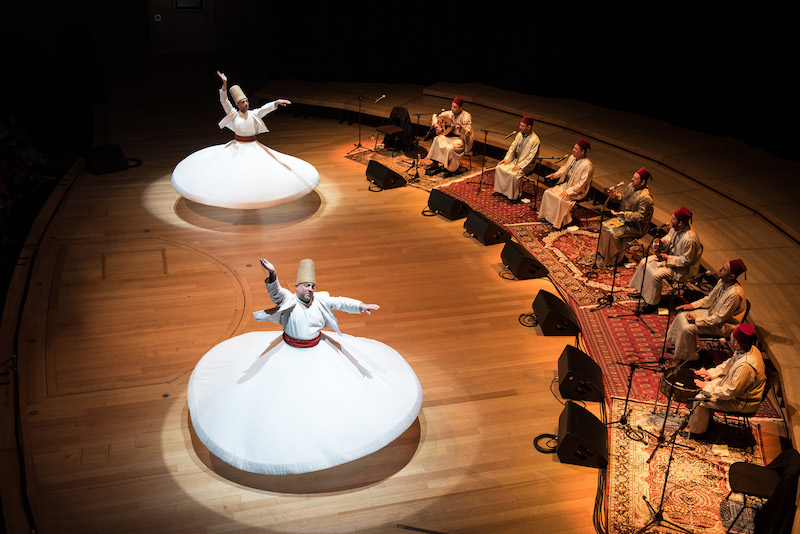
EARLY MUSLIMS WERE RECEPTIVE TO VEDIC THOUGHT
In the early days of Islam, they were more ready and open to learn from India and to look into the knowledge that was provided by the Vedic philosophy. Unfortunately, with the decline of the Abbasid power by around the middle of the ninth century, the direct exchange between India and Baghdad was practically cut off.
With the fall of Arab power, the leadership of Islam went into the hands of the Turks as a result of which Islamic culture and learning were decentralized. The new situation thus created was not very favorable to the spread of Indian thought in the lands dominated by the Turks who were not so respectful towards Indian culture as the Arabs.
In conclusion, Edward Pococke writes about the evidence that shows how Persia was but an extension of Bharatvarsha and the Vedic culture:
The ancient map of Persia, Colchis, and Armenia is absolutely full of the most distinct and starling evidences of Indian colonization and what is more astonishing, practically evinces, in the most powerful manner, the truth of several main points in the two great Indian poems, the Ramayana and Mahabharatha. The whole map is positively nothing less than a journal of emigration on the most gigantic scale.12
(Excerpts from the book Mysteries of the Ancient Vedic Empire)
References:
- Poonai, Premsukh, Origin of Civilization and Language, Dayton Beach, Florida, Pearce Publishers, Inc.,1994, p.170.
- Motwani, Jagat K., India Reborn: Bharat Mahan As Perceived by Westerners, Gandhi, Nehru, Tagore & Others, 2012, p. 190.
- Muller, Max, Science of Language ,Vol. II, p.170. Muller, Max,
- Muller, Max, Chips From a German Workshop, Vol. I, p. 83.
- Haywood, John, The Ancient World, New York, Metro Books, 2013, p.124.
- Shah, Niranjan, Iranians and Indians are Cousins, India Tribune, November 6, 2004.
- Childe, V. Gordon, The Aryans: A Study of Indo-European Origins, 1926, p.19.
- Shah, Niranjan, Iraq–A Center of Vedic Civilization, India Tribune, May 10, 2003.
- Gadre, Mrs. Medha Vishwas, India’s Cultural Links With Africa Since Ancient Times, Afro-Hindu Vision, International Centre for Cultural Studies, Nagpur, India, 1998, p.88.
- Siddiqi, W. H., India’s Contribution to Arab Civilization, India’s Contribution to World Thought and Culture, Vivekananda Kendra Prakashan Trust, Chennai, India 1970, p.586-7.
- Bhattacharya, N. N., India’s Contribution to Islamic Thought and Culture, India’s Contribution to World Thought and Culture, Vivekananda Kendra Prakashan Trust, Chennai, India 1970, p.575.
- Pococke, Edward, India in Greece; or Truth in Mythology, London, Richard Griffin and Company, 1856, p.47.


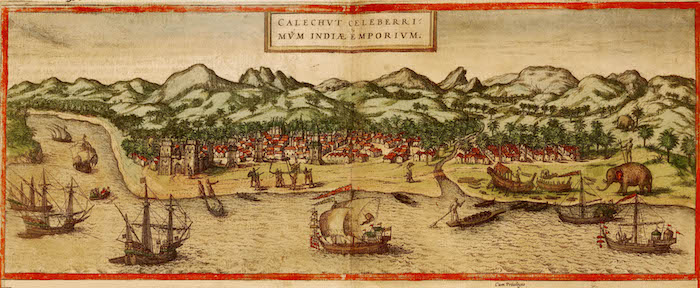


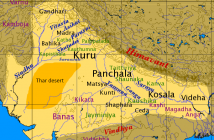

8 Comments
Ancient history of Lohanas says that they lived and fought for many centuries in those areas before being driven out by Muslims. They were descendants of Ram’s son Luv. i.e. his army and cultural and dharmic children not literally biological offspring. Please see link
http://www.genealogywise.com/forum/topics/lohana-history
Namaskar Stephen Knapp .Suprovatam. I am always waiting for your article. Wonderful thought and remarkable truth — you always give us.. We had everything, we spread all over the world through our two great epic.. I want to know more about this. I live in Bangkok and I am a guide of National Museum Volunteer’s, Bangkok.. Our Museum is full with Indian History and God and Goddess. I love learning and try to find the truth, which is base of SEA. YOU ARE MY INSPIRATION. this is one kind of Desh Seva… Thank you so much.
Anita Bose
From Bangkok.
Very educative.
It gives a feeling of fraternity. We all are close relatives.
What about the Yezidi people?? Their culture seems to be very closely related to both Vedic and Sumerian cultures, while their ethnic type make them quite similar to the Kalash people of North India. Is there a link??
Kudos to Stephen Knapp for this very euridite article tracing Hindu footprints across Persia and Mesapotamia.
Ram Ohri
1. I intent to write a novel ,based on historical facts on ancient Vedic Bamiya ( Bhramsthan) Bamiyan or varmayana, “coloured” in Sanskrit translated as ‘The Place of Shining Light’ ” the kingdom of Brahmans kalifa “, where Vedic followers wre engaged in transliteration of Vedas/Upnisads during Post-Rig Vedic (circa. 1100–500 BC) . Bamiya,situated along the banks of Bhrammi river , Aaryavrata, (Aryana) Arian, ancient Afghanistan ,) during ” ‘Later Vedic period ‘ of Bharat-varsh or ‘ Bharat’ ki Varsa ‘ of Aryavarta,
2. The novel revolves around Sisad Salah ( trishat), Yogi Bhramkit , Salasal Yogi Bhramkit “Father of the Saints”, who is said to have descended from Tushita (heaven) on to the Bamiya earth ,and lived amidst pastrol tribals , nomadic migration, trade activities ,giving Vedic Sermons to all who visited him .
3. The novel time spans during Medes domination in Bamiyam (1500 BC–551 BC ,in general and first Iranian dynastic Empire, under the Medes rule (728-550 ) in particular . Bamiya a nodal trade junction, connecting ancient Sindhudesh ,Hndukush Gandhara Pradesh ,Herat Balkh –Margu central Asian and Mesopotamian around circa 800BCE -600 BCE
4. Given the lack of historical data available on Vedic Bamiyan ,except of the Persian Hellenistic trade aggressions influences , and Varying quality in terms of historical accuracy and literary merit, a collateral fusion has been created from various corroborated digital information available on internet of e-books
5. Though I am not a historian , but my interest on ancient Afganistan tempted me to research and throw light on hidden forgotten history.It should be remembered that this book may be written for entertainment rather than as a historic document . Hence this choreographed fictious historical novel deals with daily life at Bamiyan durimg 900 BC to 600 BC before annexation by Persians
Since the purest gems lie hidden in the bottom of the ocean or in the depth of rocks & one has to dive into the ocean or delve into the rocks to find them out. Similar truth lies
Concealed in the available text history which needs to be interpolated withim historical passage of time (tomb -mile) stones that has become obsolete. Attempt to learn to interpolate the historical Time-Era mile stones before the truth is discoversed
The first part of the name” Bam “ is derived from the name Bam, a city built by Parthian kings during the Persian rule in present day Iran . while “ yan “ is derived from Himalyan ,a mountain range , meaning a city in close to Himalayan mountain ranges. In the Bam type urbanization on Bam-yan situated on the foot his of various Himalayan is on the mid point on the major trade route , linking various tribes,culture connecting Bam to Bamiyan
1 Though the cause of the destruction of the Sindhu regions (around 1700 BCE) is debatable, although evidence suggests it was caused by natural disasters (especially flooding or tetonic disaster ) changed the course of anciemt Saraswati, Suvastu (Swat Valley: ) Avestan Haraxvatī in Paramdesh (Greek Paropamisadse ) Upganistan (Afganistan )
2 Attempts to script of R V epic hymns,mantras recited in the Prakit Vedic Sanskrit language & Srutis (heard) Aurti( listened) and recited”by Smriti (remembered ) Vaktru “by Rishis,Mubi,Sages from Suvāstu ( Swat Valley at Bhrami( Bamiyan) river plateau for a creative assembly
3 Collecting information from records for the Vedic Afghan history from the primary materials that are scattered and poorly preserved,for a creative assembly , Though the distance of time blurs our view of the of Bamiya Rishis Munis who appear to have lived on river terraces and inhabited caves and rock shelters(before advent of Budhisim )
4 . During the 1500 to 500 BCE. time period, the told tales of gods and wars by Mandalas of .Rish Ved ( Gayan) was eventually sophisticated and developed in Bamiyan ” kingdom of Vedic Brahmans,”
5 Collecting information from records for the Vedic Afghan history from the primary materials that are scattered and poorly preserved,
+